人教版(新课程标准)必修三Unit 4 Astronomy: the science of the stars Reading阅读课件 (21张PPT)
文档属性
| 名称 | 人教版(新课程标准)必修三Unit 4 Astronomy: the science of the stars Reading阅读课件 (21张PPT) |  | |
| 格式 | zip | ||
| 文件大小 | 2.0MB | ||
| 资源类型 | 教案 | ||
| 版本资源 | 人教版(新课程标准) | ||
| 科目 | 英语 | ||
| 更新时间 | 2023-01-06 18:32:35 | ||
图片预览

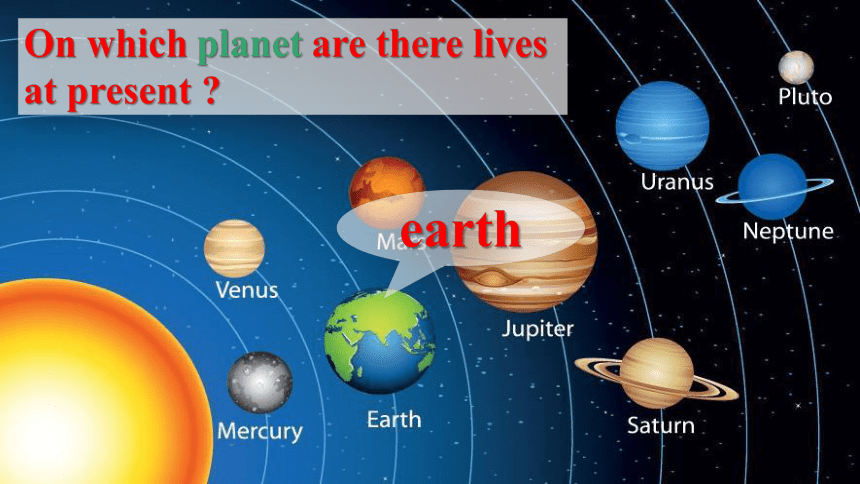
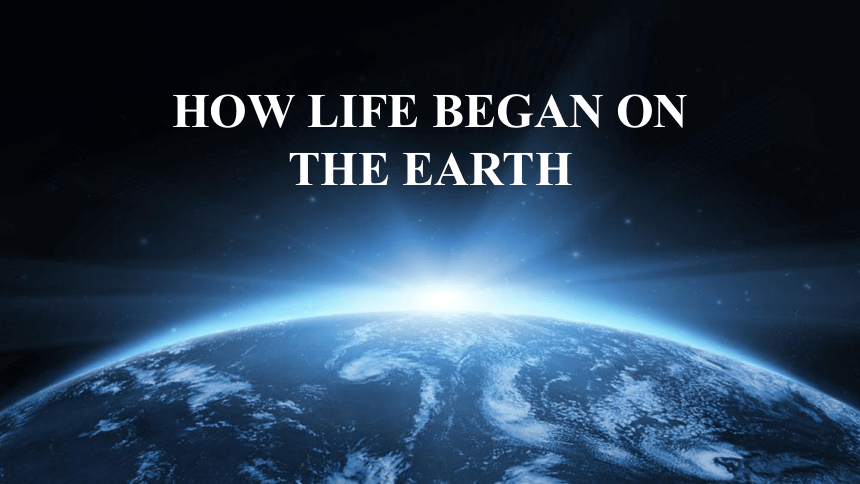
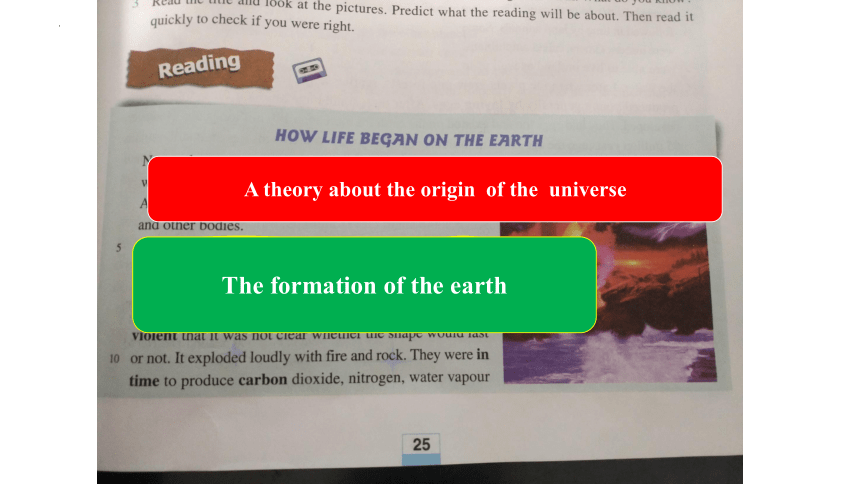
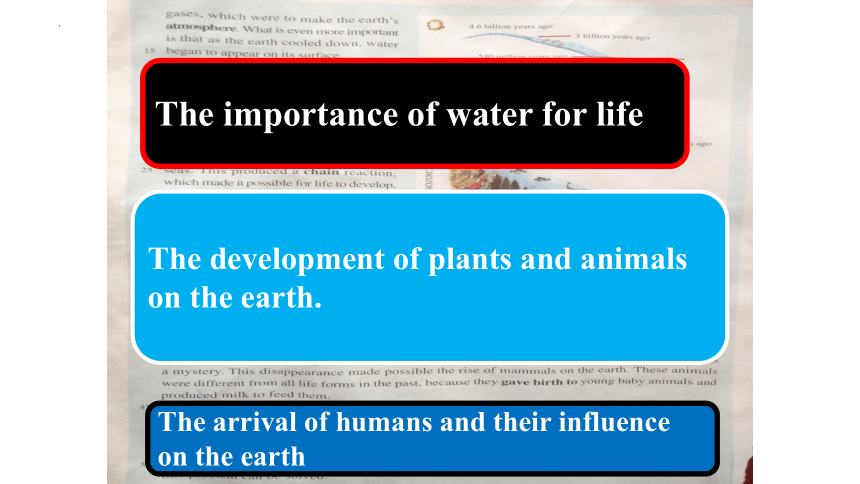

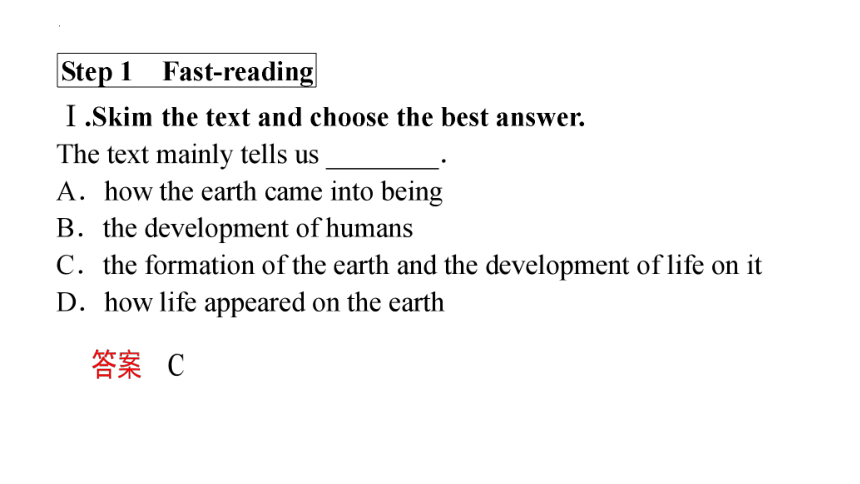
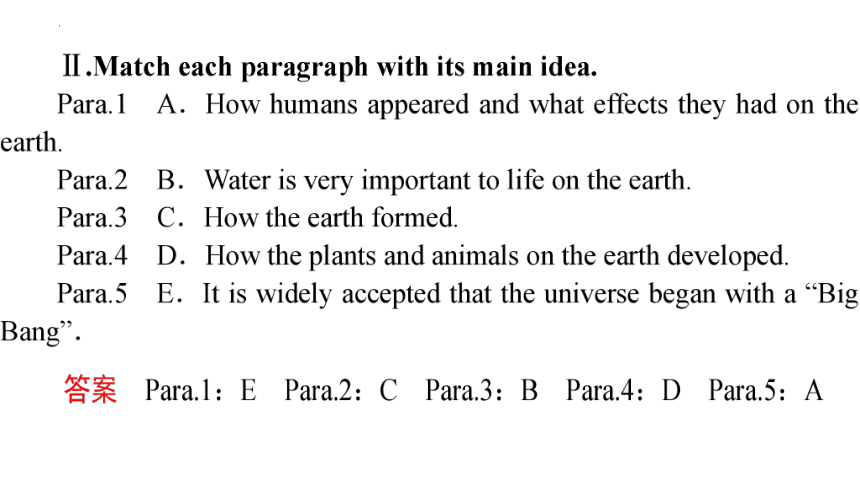
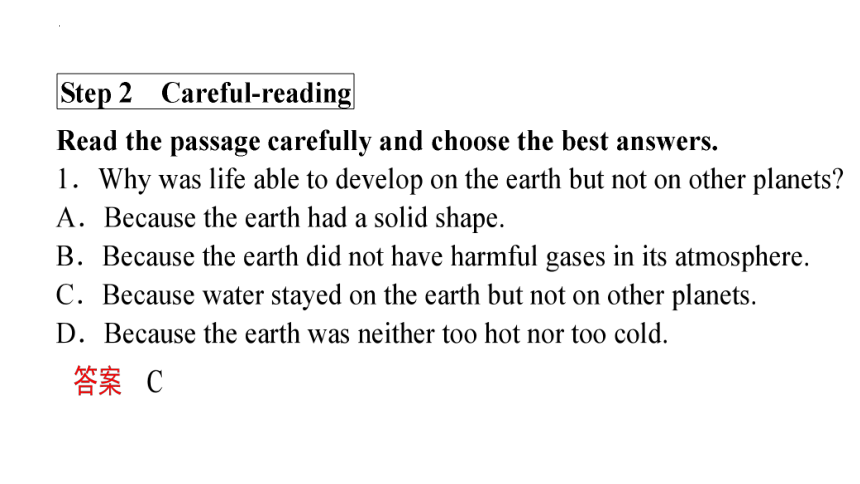
文档简介
(共21张PPT)
Unit 4 Astronomy
On which planet are there lives at present
earth
HOW LIFE BEGAN ON THE EARTH
A theory about the origin of the universe
The formation of the earth
The importance of water for life
The development of plants and animals on the earth.
The arrival of humans and their influence
on the earth
Check your answers!
Detailed - reading
No one knows exactly (how the earth began), as it happened so long ago. However, according to a widely accepted theory, the universe began with a “Big Bang” (that threw matter in all directions). After that, atoms began to form and combine to create stars and other bodies.
For several billion years after the “Big Bang”, the earth was still just a cloud of dust. (What it was to become) was uncertain until between 4.5 and 3.8 billion years ago when the dust settled into a solid globe. The earth became so violent {that it was not clear (whether the shape would last or not)}. It exploded loudly with fire and rock. They were in time to produce carbon dioxide, nitrogen, water vapour and other gases, (which were to make the earth’s atmosphere). (What is even more important) is (that as the earth cooled down, water began to appear on its surface).
Water had also appeared on other planets like Mars but, unlike the earth, it had disappeared later. It was not immediately obvious (that water was to be fundamental to the development of life). (What many scientists believe) is (that the continued presence of water allowed the earth to dissolve harmful gases and acids into the oceans and seas). This produced a chain reaction, (which made it possible for life to develop).
Many millions of years later, the first extremely small plants began to appear on the surface of the water. They multiplied and filled the oceans and seas with oxygen, (which encouraged the later development of early shellfish and all sorts of fish). Next, green plants began to grow on land. They were followed in time by land animals. Some were insects. Others, called amphibians, were able to live on land as well as in the water. Later when the plants grew into forests, reptiles appeared for the first time.
They produced young generally by laying eggs. After that, some huge animals, called dinosaurs, developed. They laid eggs too and existed on the earth for more than 140 million years. However, 65 million years ago the age of the dinosaurs ended. (Why they suddenly disappeared) still remains a mystery. This disappearance made possible the rise of mammals on the earth. These animals were different from all life forms in the past, because they gave birth to young baby animals and produced milk to feed them.
Finally about 2.6 million years ago some small clever animals, now with hands and feet, appeared and spread all over the earth. Thus they have, in their turn, become the most important animals on the planet. But they are not looking after the earth very well. They are putting too much carbon dioxide into the atmosphere, (which prevents heat from escaping from the earth into space). As a result of this many scientists believe the earth may become too hot to live on. So (whether life will continue on the earth for millions of years to come) will depend on (whether this problem can be solved).
Unit 4 Astronomy
On which planet are there lives at present
earth
HOW LIFE BEGAN ON THE EARTH
A theory about the origin of the universe
The formation of the earth
The importance of water for life
The development of plants and animals on the earth.
The arrival of humans and their influence
on the earth
Check your answers!
Detailed - reading
No one knows exactly (how the earth began), as it happened so long ago. However, according to a widely accepted theory, the universe began with a “Big Bang” (that threw matter in all directions). After that, atoms began to form and combine to create stars and other bodies.
For several billion years after the “Big Bang”, the earth was still just a cloud of dust. (What it was to become) was uncertain until between 4.5 and 3.8 billion years ago when the dust settled into a solid globe. The earth became so violent {that it was not clear (whether the shape would last or not)}. It exploded loudly with fire and rock. They were in time to produce carbon dioxide, nitrogen, water vapour and other gases, (which were to make the earth’s atmosphere). (What is even more important) is (that as the earth cooled down, water began to appear on its surface).
Water had also appeared on other planets like Mars but, unlike the earth, it had disappeared later. It was not immediately obvious (that water was to be fundamental to the development of life). (What many scientists believe) is (that the continued presence of water allowed the earth to dissolve harmful gases and acids into the oceans and seas). This produced a chain reaction, (which made it possible for life to develop).
Many millions of years later, the first extremely small plants began to appear on the surface of the water. They multiplied and filled the oceans and seas with oxygen, (which encouraged the later development of early shellfish and all sorts of fish). Next, green plants began to grow on land. They were followed in time by land animals. Some were insects. Others, called amphibians, were able to live on land as well as in the water. Later when the plants grew into forests, reptiles appeared for the first time.
They produced young generally by laying eggs. After that, some huge animals, called dinosaurs, developed. They laid eggs too and existed on the earth for more than 140 million years. However, 65 million years ago the age of the dinosaurs ended. (Why they suddenly disappeared) still remains a mystery. This disappearance made possible the rise of mammals on the earth. These animals were different from all life forms in the past, because they gave birth to young baby animals and produced milk to feed them.
Finally about 2.6 million years ago some small clever animals, now with hands and feet, appeared and spread all over the earth. Thus they have, in their turn, become the most important animals on the planet. But they are not looking after the earth very well. They are putting too much carbon dioxide into the atmosphere, (which prevents heat from escaping from the earth into space). As a result of this many scientists believe the earth may become too hot to live on. So (whether life will continue on the earth for millions of years to come) will depend on (whether this problem can be solved).
同课章节目录
